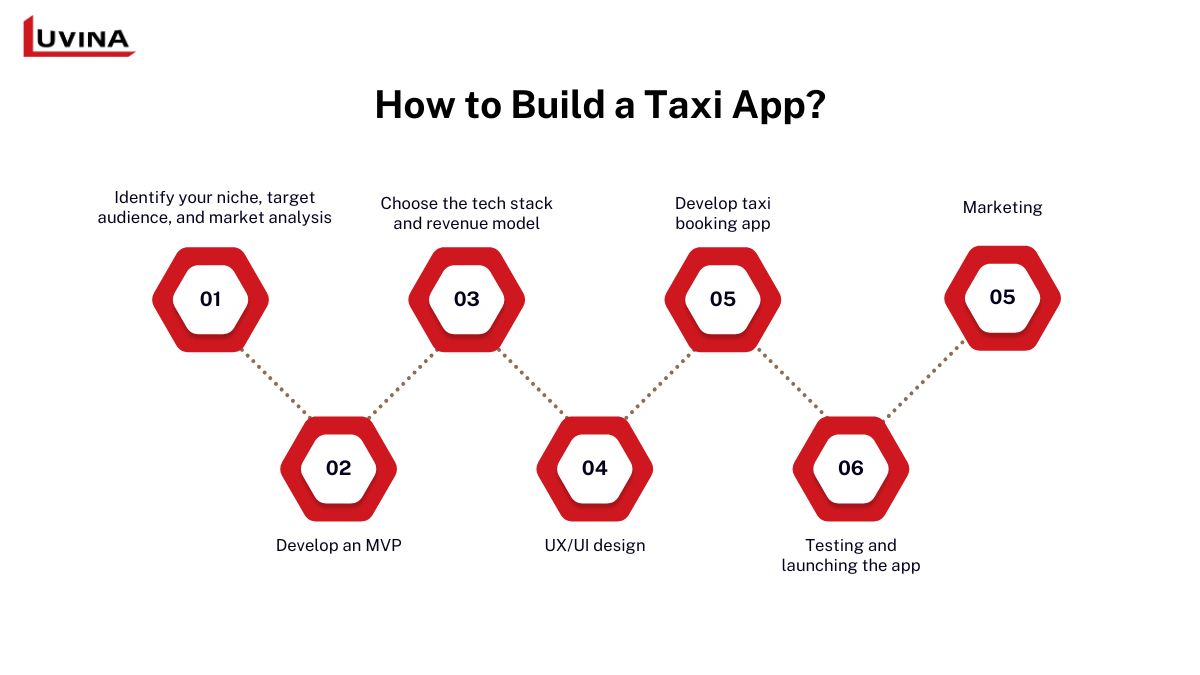Conventional ways of living are being adorned with technology to make life easier and so is the case with taxi booking. It also led to a significant trend of taxi booking app development in the technology industry. It is predicted that the taxi app market will reach a value of $283 billion by 2028, while the annual growth rate from 2023 to 2028 is 4.2%. Interestingly, according to a report in 2022, the leading taxi app, DiDi, earned a profit of $19.7 billion, while Uber earned $14 billion. All these figures show the huge potential of taxi app development, and you also can reach this profitability if you develop your own taxi app.
So, how does a taxi app work, and how can you make your own one? In this article, we will help you understand:
- What is a taxi application?
- The must-have features in the taxi booking mobile app development.
- How to create a taxi app.
- The cost of taxi application development.
Keep reading to discover more!
What is a Taxi booking app?
Taxi booking apps allow users to book taxis quickly through mobile devices. Along with the help of some smart features and the usage of the internet, you can book a ride and the driver will take you to your desired location. In addition to basic booking, such applications have many other additional features that include scheduling your trip for a particular time, calling or messaging the driver, route tracking, and card payments.

If you are interested in taxi booking app development, the very first thing to know is that any taxi app can always be more than just one standalone application. Such an application has to serve three broad categories of users: customers, drivers, and administrators. All these categories have different use purposes. The functionalities designed for these groups will differ. Therefore, when talking about taxi app development, you want to build a “3-in-1” app, or even more than that-separate apps to appeal uniquely to every user group.
Uber was the pioneer in taxi booking mobile app development. In 2009, the company successfully built a taxi app, contributing to a significant transformation in the taxi service market. Following Uber’s success, other taxi service providers also launched their own app solutions and achieved remarkable results.
So, how does a typical taxi app work? As mentioned above, cab booking app development caters to the needs of three main user groups: customers, administrators, and drivers.
For customers, the taxi booking app is a tool for finding a ride from one point to another, with a primary focus on user-friendliness and a seamless experience.
For administrators, the app functions as a dashboard, enabling them to manage bookings, oversee customers and drivers, and control operational workflows.
For drivers—arguably the most essential user group for companies focusing on taxi booking app development—the app acts as a job portal. It provides detailed job information, performance analytics, revenue reports, communication tools for interacting with customers, and GPS navigation. Among the three user groups, the driver-facing app typically has the most diverse functionalities.
Key Features to Create a Taxi Application
Defining the features plays a crucial role in taxi booking app development. Features not only impact the overall taxi app development cost but also determine the kind of team you need, the development timeline, and the scale and complexity of the application you aim to create.
As mentioned earlier, taxi mobile app development must address the needs of three key user groups: customers, administrators, and drivers. Below, we have compiled a list of essential features that a taxi booking app should include to meet the demands of these three groups effectively.

1. Customer panel
To create a taxi booking app that meets the needs of customers for booking rides and performing other tasks such as payment, driver ratings, and journey tracking, you should consider integrating the following features:
- Login/registration: Allows customers to join the system, securely store their data, and access the app seamlessly.
- Customer profile: Enables users to track trips, update personal information, and enhance the convenience of using the app.
- Payment options: Offers multiple payment methods besides cash to provide a more convenient payment experience.
- GPS tracking: Lets customers monitor the route and estimated time during the ride, track the driver’s location, and know when the driver will arrive.
- Fare calculator and route planner: Automatically calculates costs, routes, and travel time, allowing customers to plan trips and know exactly how much each ride will cost.
- Taxi booking: The most essential feature for any online taxi booking app development, enabling customers to book a ride from point A to point B directly from their smartphones.
- Messaging and calling: Facilitates quick and easy communication between customers and drivers for inquiries or sharing important information.
- Push notifications: Keeps customers informed when a driver messages them, when they are nearing their destination, or when a driver has been assigned to their request.
- Ratings and reviews: Provide insight into each driver’s reliability and empower customers to leave feedback about their trips.
- Ride history: Tracks previous rides, including completed and canceled trips, for better record-keeping and convenience.
In addition to these core features, you can customize your taxi app with advanced functionalities such as multi-destination booking, bill splitting, booking rides for friends or family, and multi-language support. These enhancements can make your app stand out from competitors and deliver an exceptional user experience.
2. Driver panel
A taxi booking app serves as a workspace for drivers, helping them manage rides efficiently. To achieve this, you should consider integrating the following features when you make a taxi app:
- Login/registration: Allows drivers to securely log in or register in the system. Including two-factor authentication is recommended to protect sensitive information such as bank account details.
- Driver profile: Enables drivers to manage personal information, similar to customer profiles.
- Navigation and Route Optimization: Provides built-in navigation and route optimization features, eliminating the need for third-party GPS tools and offering drivers a seamless experience.
- Messaging alerts: Notifies drivers when customers have questions or need to discuss trip details, ensuring timely responses.
- Statistics and Earnings Tracking: Allows drivers to monitor completed trips, track their income, and manage their financial performance effectively.
- Push notifications: Keeps drivers updated on ride statuses, new booking requests, and trip updates in real-time.
Additionally, you can enhance your app by incorporating advanced features such as the ability to accept or decline ride requests, start or end trips, cancel bookings, and provide driver feedback on customers.

3. Admin panel
For administrators, a taxi booking app serves as a tool to manage the entire system and support both drivers and customers. Therefore, in taxi booking app development, integrating the following features is essential to meet the needs of administrators:
- Dashboard: Provides control over key metrics such as the number of rides booked, revenue, commissions, and driver availability. It centralizes all the information administrators need to ensure smooth operations.
- Reports and analytics: Offers insights into driver and app performance, helping identify issues, enhance customer experience, and increase revenue.
- Map view: Displays real-time locations of drivers and customers, enabling better coordination and on-the-spot assistance when required.
- Vehicle and user management: Allows tracking of driver and vehicle information for better service delivery. Administrators can add, remove, update, and manage drivers and their vehicle details within the system.
How to Build a Taxi App?
By now, you know what a taxi booking app is, how it works, and the features to include in one. Based on that understanding, you are all set to proceed with the taxi booking software development. Here’s an elaborate development process for you.

Step 1: Identify your niche, target audience, and market analysis
Before diving into your taxi booking app development project, it’s highly important to gather all the details so you can define the app you want to develop. Thus, this preparation will help you much when you create your development plan and discuss requirements with outsourced teams, if applicable.
First, get a feel for your market and audience. Identify the market you wish to serve, then analyze that market and its competitors for the insight to be leveraged. This process will help you shape your goals and address specific needs. Based on this market research, you can identify the most suitable business model for your company.
To gather valuable information to build a taxi booking app, ask yourself the following questions:
- – Who are your current customers, and who are your potential future customers?
- – Will your customers be willing to try your app?
- – What are your customers’ expectations?
- – Who are your competitors in this niche, and what will make your product stand out?
Step 2 – Develop an MVP
MVP will be a very good starting point for on-demand taxi app development. Creating an MVP means you are developing a very basic version of the future app with minimal functions aimed at giving an overall view of how the app will look. To prepare for MVP development, you need to make a list of the most basic features you want to include. Designers and business analysts will assist you in setting up a process to maximize return on investment from the very beginning. To choose the features to include in the MVP, you should base your decision on the following criteria:
- – The complexity of the feature.
- – The importance of the feature in the taxi booking app development that you want.
- – The best time to implement the feature.
- – The cost of the feature.
From our experience, you should develop the taxi booking app for customers first, then move on to the app for drivers and administrators.
Step 3 – Choose the tech stack and revenue model
Next comes the selection of an apt technology stack to build your on-demand taxi booking application. This is where we suggest discussing the supporting services, payment solutions, databases, etc., that will come into play with your on-demand taxi booking application development partner.
Apart from that, one more important aspect you should discuss and decide upon early pertains to the revenue model, or in other words, how you will make money from the app. Now, there are several ways you can make money from a taxi booking app. You must study them carefully to decide which one would work best for you.
Step 4 – UX/UI design
Nowadays, the app market is all about user experience. If you want to successfully develop a taxi booking app like Uber, it should necessarily ensure the best experience for the users. That’s why UX/UI design is considered to be one of the most vital parts of on-demand taxi booking app development. An attractive yet friendly design will keep users coming back for more. Thus, it is a good investment to create an easy-to-navigate UI that provides seamless experiences.

While designing the user interface of the taxi app, you are supposed to keep in mind that the interface shall be operable, intuitive, quick, and simple. All color blocks, fonts, and icons must be thought over to maintain two things: a pleasing user experience and reflecting your company’s identity.
Step 5 – Develop a taxi booking app
This is, in fact, the most elaborate and time-consuming part of the entire taxi booking app development project. In this stage, the development experts bring your idea into the foreground, create a taxi app and make sure it possesses an amalgamation of features desired by different users. The development of a taxi app can either be done by creating an in-house development team or you could hire an external company of developers.
We recommend working with a professional taxi booking mobile app development company like Luvina, who will help you work with skilled designers and skilled developers. Working with Luvina can save your time in the development cycle, and you can offer your taxi booking app to the market fast.
Step 6 – Testing and launching the app
After the development of a taxi booking app, subsequent testing comes into play. Testing has to be carried out under variant conditions and on multiple variants of devices by QA specialists, with the view to make the application provide seamless users’ experience, process data securely, and become reliable in functionality.
The functional testing, security testing, usability testing, user interface testing, etc., will be included in the testing process. Once the testing process is complete, your taxi app is good to go live on stores. Make sure you follow the respective guidelines while deploying your app smoothly, be it Google Play Store or Apple App Store.
Step 7 – Marketing
After the development and launching of a taxi application, you have to start its marketing to attract users and encourage them to interact with your new application. In the ideal world, you should have a very clear marketing plan before going live so you can target your audience right when the app hits the market. Here are some advertising tips to attract users to your taxi booking app:
- – Leverage social media platforms like Facebook, Instagram, and advertising channels such as Google AdWords.
- – Utilize local media to gain attention.
- – Advertise the app through newspapers, radio, and TV.
- – Highlight the unique features of the app to make it stand out from competitors in the market.
- – Submit the app to various review websites before release.
- – Partner with local businesses and engage in brand-building activities.
- – Launch attractive promotional offers and discounts.

Taxi Booking App Development Cost
The taxi booking app development cost depends on many factors, such as the size and complexity of the app, the location of the development team, and the technology used. Complex apps can meet the needs of many different users and make a mark in a crowded market. However, their complexity will also increase both the cost and development time. Currently, most taxi booking apps are divided into small, medium, and large types. Here are the estimated costs to make a taxi app based on the scale:
- Basic taxi app: Includes simple features and focuses on one specific platform (iOS or Android). These basic taxi booking apps take 2 to 4 months to develop, with development costs ranging from $10,000 to $20,000. This type of app is ideal for businesses or startups looking to test the market by launching an MVP.
- Mid-range taxi app: Includes more advanced features, developed for both iOS and Android, with a development timeline of 4 to 7 months. The cost of taxi booking app development for a medium-scale app ranges from $20,000 to $50,000. A mid-range taxi app development is the best choice for companies looking to invest more in providing a high-quality product and competing in the market.
- Complex taxi booking app: Takes the most time and costs the most to develop. On average, the taxi app development cost for a complex app ranges from $50,000 to $200,000, or even more. This budget is used to pay for additional features, modifications, and scalability of the app in the future. Complex taxi apps take 7 to 12 months to develop, depending on the complexity. Taxi booking software development for complex apps is suitable for large businesses or established companies looking to pioneer in the market. These apps always come with all the features needed to ensure a great user experience, as well as high operational efficiency and security.
Conclusion
We hope the detailed guide above has helped you understand how to create your own taxi app and provided you with ideas to perfect your dream app. Taxi booking app development will certainly help your business increase the number of customers, provide a better service experience, and ultimately boost profits. So, what are you waiting for? Contact Luvina today to customize a taxi app that can help your business grow.
Related Posts:









Read More From Us?
Sign up for our newsletter
Read More From Us?
Sign up for our newsletter